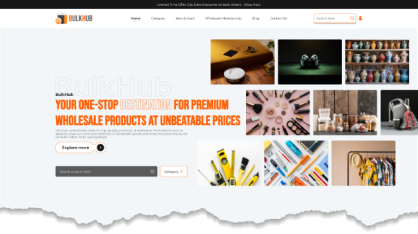Introduction
Recently, one of my friends Amit came to me. He runs an eShop and a showroom of fancy clothes. He tries to make his showroom the finest in his area. His showroom is located in an area where all financially wealthy people live. In order to receive and show them the latest designs, he hired a huge staff. The high-paying customers can easily afford to buy designer clothes and other fashion accessories. Amit follows all the latest trends. And recently he launched his own brand too. Despite this, he finds it difficult to survive in competition with other professionals. Because 10 more such showrooms have been opened in the area where his showroom is located. Now, no matter how hard he tries, his showroom is not as crowded as it used to be.
So he decided to focus solely on his eShopping business website. Unfortunately, the competitors for an online business are already struggling to get the top position in search engine results and now Amit also wants to improve the SEO of his website.
It’s not only the Amit is facing this situation. The competitiveness in every industry has become a subject of discussion. Every business is trying hard to survive and thrive.
Every business person is working hard day and night to enhance their SEO ranking. When WordPress emerged and people started to prefer it as a CMS for developing their websites, everyone is looking for an effective solution to boost their business growth and SEO rank. It has been observed that most of the websites don’t go through clear and well-planned SEO. The SEO practices must apply effectively and must produce a sustainable and long-run result.
A comprehensive SEO strategy must be there to bring your site to the top of the search rankings and sustain its position consistently.
Amit wants to check whether his website is properly optimized for search engines or not.
So to ensure this, I suggested that he should go through a WordPress SEO checklist which will help him to grow the traffic on the site and get a higher rank on the Google search engine as we all know that most of the traffic comes from the search engine. Additionally, he can also consider integrating Premium WordPress themes to enhance the overall user experience and visual appeal of his website, which can further contribute to better SEO results.
Now here, I am going to share a WordPress SEO checklist for all. Before that, let’s look at the points to be covered in the blog.
Table of content
- Install the WordPress SEO plugin
- Configure the Search Engine Webmaster tools
- Inserting Google Analytics into WordPress
- Perform keyword research for your WordPress website
- Make use of LSI Keywords and check for Keyword Stuffing
- Minimise the SEO title and Meta Description of your website.
- Make use of SEO-friendly URLs
- Insert the Alt-text to your images
- Insert links to the content
- Enhance the readability of your content.
Beginners like Amit are not aware of the technical terms, SEO tactics, and new trends that can put off their optimized business websites to rank higher in search engines. For this, the WordPress SEO checklist helps you out. In this, you can have information about the best SEO tools and plugins. Now let’s have a look at the WordPress SEO checklist for beginners.
10 essential steps to improve your rankings
1. Install the WordPress SEO plugin
Installing an SEO WordPress plugin is the best way to set up your WordPress site for search engines. The All-in-One plugin is the highly recommended plugin for your website that helps you optimize your site for search engines. It does not require any kind of technical knowledge or hiring a developer.
AIOSEO is a feature-rich plugin. It offers powerful features like creating an XML sitemap, adding schema markup, integrating social media, breadcrumb navigation, TruSEO On-Page analysis score, robots.txt editor, local SEO, WooCommerce SEO, link assistant, tracking broken links, and many more. The plugin can also be useful for conducting an SEO audit. It also monitors crucial issues. If you really want to boost the organic traffic on your website, then the All-in-One plugin is the ultimate solution.
2. Configure the Search Engine Webmaster tools
After a successful installation of the AIOSEO plugin, next, you will have to configure the various search engines’ webmaster tools, such as Google Search Console, Bing Webmaster Tools, and Yandex Webmaster Tools.
All these tools are free tools and are used for tracking the website’s organic search performance. It also helps to recognize the keywords that people are using to find your website. Apart from that, the tools can check rankings, submit sitemaps, uncover errors that can prevent your site from ranking in search engines, and more.
You can take a Google Search Console as an example which is used to index the searched results for multiple pages, fix any issues, and submit pages for indexing.
3. Inserting Google Analytics into WordPress
Inserting Google Analytics is an excellent tool to track website traffic and embedding it into your WordPress website plays a vital role in tracking the user behaviour on your site. It includes all the details about the user. For example, from where the users are operating your website, which pages they view, and a lot more.
Besides that, the tool discovers the high-converting pages and enhances the SEO. It also tracks the 404 error and boosts organic traffic.
If you want to configure Google Analytics in an easy way, then you can use MonsterInsights. You won’t have to play with the codes or contact a particular developer to set up GA. Its premium version can give you extraordinary features such as eCommerce tracking and form conversions.
4. Perform keyword research for your WordPress website
It’s a very important step and technique for researching keywords. Content creators and SEO experts must make use of it to find out the topics in which your audience is interested.
Most beginners do this job just by guessing the best to come up with topics that they think people might like. Instead of this, you must perform proper keyword research and explore the search terms for every page on the website.
For this, you can make use of various keyword research tools available in the market. For the primary search term, Semrush is a highly recommendable tool that offers in-depth keyword data, keyword position tracking, competitor analysis, related keywords, questions, and more. You can go with the free tools also for primary use.
5. Make use of LSI Keywords and check for Keyword Stuffing
Once you know to track the primary keyword, now you can move ahead to find out the Latent Semantic Indexing (LSI) keywords. These are related search queries to your primary keyword which is related to the main keyword. You can use Google search to find out the LSI keyword easily. Now you must be thinking how? Right?
At the bottom of the search results page on the site, you can see the ‘Related searches’ section which helps you to find out the LSI keyword.
These are the terms that you can use throughout your content. It helps the search engines better understand your content. Don’t stuff these keywords and terms unnecessarily. Overuse of the keywords won’t give a pleasant reading experience for users. Search engines can detect keyword stuffing smartly.
6. Minimize the SEO title and Meta Description of your website.
Now the next point you have to check in the WordPress SEO Checklist is to check whether your SEO titles and meta descriptions are optimized or not.
In reality, the title of your WordPress blog post or product page plays a vital role in search rankings. An attractive title captures the user’s immediate attention. Also, the users can get additional information from the meta description about the page which helps to enhance the organic click-through rate (CTR). More the users who click the link of your website, the more Google help you achieve higher rankings. It is an important task to add the primary keyword in the SEO title and Meta description in your post. So you need to follow the limit of 55 characters in the title and 155 characters in the meta description.
If you cross the limit, Google will diminish the headline and description on the website. The All In One SEO plugin uses the headline analyzer to generate engaging title tags. You can get tips to enhance the SEO title of your website and displays a score for your headline.
7. Make use of SEO-friendly URLs
Some website URLs of certain pages and blogs seem very complicated which search engines cannot find easily. So you must minimize the URL of your posts and landing pages for better SEO. Also, the permalink must be short and descriptive. It helps the users to understand the motive of the page in the search results. It is more than better to use a primary keyword in your URL.
8. Insert the Alt-text to your images
Alike text optimization, optimizing images for search engines is an equally important task in WordPress SEO. So, to optimize the images on your website, you must make use of the descriptive alternative or alt text.
Due to this, Google and other search engines can understand the subject of an image. In this way, your photos will appear in Google Images and get you more organic traffic. It’s very easy to insert alt text to your images in WordPress. You can get the Alt text option in the WordPress content editor when you upload an image on the right side.
Also, you can navigate to the Media->Library from the admin panel.
Pick any image and type the ‘Alt Text’ in the right side panel. You can adjust the image size with the help of an image compression tool.
9. Insert links to the content
Internal links in the website really help you to improve the SEO. the internal links are nothing but the pages on your website. Search engines make use of these links to discover and index content on the website. In addition to this, visitors can navigate your website easily, reads related posts, find sources for statistics, and explore old articles and pages.
10. Enhance the readability of your content
Enhancing the readability of content means creating quality content that users can understand easily and enjoy reading. It issues 100% effective results in terms of getting a higher rank. It’s very essential while checking for on-page SEO. Readers on blogging sites must get convinced that you are going to engage them for a long once they scan your blog. Improved readability can make able users scan your blogs quickly. The easiest way for this is to make the different sections under the headings (H2, H3, H4, and so on).
Other than this, you can keep the bulleted points and write short sentences. Insert table of contents, images, videos, and other multimedia.
Additional Key Points
That’s it! Apart from this, the following are the additional points that can enhance your SEO.
- Check the speed of the website.
- Make your site mobile-friendly.
- Make sure that the search engine can discover your site easily.






















